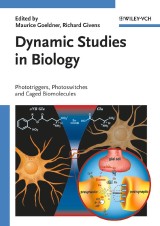Details
Dynamic Studies in Biology
Phototriggers, Photoswitches and Caged Biomolecules1. Aufl.
|
232,99 € |
|
| Verlag: | Wiley-VCH (D) |
| Format: | |
| Veröffentl.: | 06.03.2006 |
| ISBN/EAN: | 9783527605545 |
| Sprache: | englisch |
| Anzahl Seiten: | 584 |
DRM-geschütztes eBook, Sie benötigen z.B. Adobe Digital Editions und eine Adobe ID zum Lesen.
Beschreibungen
With contributions by more than 30 expert researchers, this handbook covers the whole spectrum from chemistry to cell biology and from theory to application. In so doing, it deals with a broad range of topics from the chemistry and biophysics of caged compounds to their application in time-resolved studies, comparing the properties of different caging groups. The authors describe in detail light-activation of proteins as well as nucleic acids, while a special section is devoted to multiphoton phototriggers.<br> A must-have for every biochemist, biophysicist and molecular biologist developing and working with these novel methods.
INTRODUCTION<br> <br> PHOTOREMOVEABLE PROTECTING GROUPS USED FOR THE CAGING OF BIOMOLECULES<br> Photoremovable Protecting Groups -<br> 2-Nitrobenzyl and 7-Nitroindoline derivatives<br> Coumarin-4-ylmethyl phototriggers<br> p-Hydroxyphenacyl: A photoremovable protecting group for caging bioactive substrates<br> Caging of ATP and Glutamate: A comparative analysis<br> <br> MECHANISTIC OVERVIEW OF PHOTOTRIGGERS AND CAGE RELEASE<br> <br> CAGED AMINO ACIDS AND PEPTIDES AND SOLID PHASE SYNTHESIS<br> <br> CONTROL OF CELLULAR ACITIVITY<br> Photochemical Release of Second Messengers -<br> Caged Cyclic Nucleotides<br> Caged Nitric Oxide<br> Photochemical Release of Neutrotransmitters<br> Caged Neutrotransmitters for Probing Neuronal Circuits, Neuronal Integration and Synaptic Plasticity<br> <br> PHOTOREGULATION OF PROTEINS<br> Light-activated Proteins: An Overview<br> Photochemical Enzyme Regulation Using Caged Proteins<br> The Use of Caged Proteins in Cell-Based Systems<br> <br> PHOTOREMOVABLE PROTECTING GROUPS IN DNA SYNTHESIS AND MICROARRAY FABRICATION<br> <br> ANALYTICAL TIME-RSOLVED STUDIES USING PHOTOCHMCAL TRIGGERING MEHTODS<br> Time-resolved FTIR of Caged Compounds<br> Selected Examples<br> New Perspectives in Kinetic Protein Cystallography Using Caged Compounds<br> <br> TWO-PHOTON AND MULITIPHOTON PHOTOTRIGGERS<br> <br> NEW CHALLENGES<br> Protein Folding -<br> Laser-induced T-jump method, a Nonconventional Photo-releasing Approach to Study Protein Folding<br> Early Kinetic Events in Protein Folding. The Development and Applications of Caged Peptides<br> Caged RNA: Photocontrol of RNA Processing<br> Photoregulation of Gene Expression -<br> Light Reversible Suppression of DNA Bioactivity with Cage Compounds<br> Photoactivated Gene Expression Through Small Molecule Inducers
"... belongs in the libraries of any research university or corporation that deals with novel dynamic biological processes..." E-STREAMS<br>
Maurice Goeldner was born in 1945 in Strasbourg, France, where he studied chemistry at the Université Louis Pasteur. He received his doctorate in 1972 under the direction of Dr.J.F.Biellmann, and during this time he conducted research at the Centre National de la Recherche Scientifique in Strasbourg. After posdoctoral studies with S. Wolfe (Kingston,Canada) and A. Eschenmoser (ETH,Zürich,Switzerland), he returned to Strasbourg to codirect, with his friend Christian Hirth, the Laboratoire de Chimie Bioorganique. In 1983 he was appointed Professor of Organic Chemistry at the faculté de Pharmacie. His research interests focus on bioorganic chemistry, in particular, the structural determinants of membrane receptors investigated by site-directed labeling methods.<br> <br> Richard Givens is Professor of Chemistry at the University of Kansas in Lawrence, where has been on the faculty since 1967. He received a bachelor's degree from Marietta College in Ohio and a doctorate in chemistry from the University Wisconsin, Madison. Professor Givens is an expert in mechanistic organic photochemistry, the design and synthesis of "caged" reagents or photoremovable protecting groups, photoactivated cross-linking reagents for collagen, and the mechanism and bioanalytical applications of chemiluminescence. He has published more than 100 papers and patents in these areas. He has received the Byron T. Shutz Award for Distinguished Teaching (1987) and the Mortar Board Teaching Award at KU and was awarded an honorary D.Sc. degree from Marietta College.<br>
The study of enzyme mechanisms or fast cellular regulation processes, among others, critically depends on a technique that rapidly switches on the system under study, without being disruptive to the cells or their components. A pulse of laser light may be used as a trigger, but only if the system is responding to light. Therefore, numerous photoactivatable biomolecules have been developed to act as "photoswitches" for almost every biological system.<br> With contributions by more than 30 expert researchers, this handbook covers the whole spectrum from chemistry to cell biology and from theory to application. In so doing, it deals with a broad range of topics from the chemistry and biophysics of caged compounds to their application in time-resolved studies, comparing the properties of different caging groups. The authors describe in detail light-activation of proteins as well as nucleic acids, while a special section is devoted to multiphoton phototriggers. The whole is rounded off with a look at challenges for the future.<br> A must-have for every biochemist, biophysicist, organic and photochemist, as well as molecular and cell biologists developing and working with these novel methods.


















